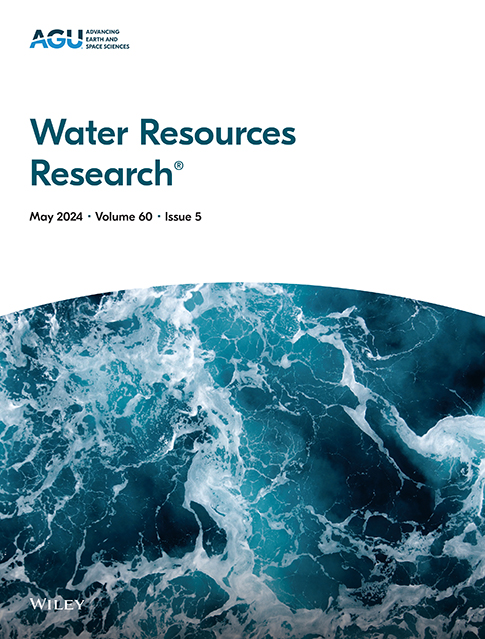Inertial Flow-Driven Enhancement of Solute Mixing and Partitioning at Rough-Walled Fracture Intersections: Experimental and Numerical Investigations
IF 4.6
1区 地球科学
Q2 ENVIRONMENTAL SCIENCES
引用次数: 0
Abstract
This study investigates the impact of the transition from viscous linear to inertial nonlinear flows on solute mixing and partitioning at rough-walled fracture intersections, using direct observations of flow dynamics and solute partitioning processes through microscopic particle image velocimetry. It is generally known that mixing at fracture intersections decreases when transport shifts from diffusion-dominated to advection-dominated processes, but this trend holds only in viscous linear flows. The experimental results conducted in this study reveal that in inertial flows, significant changes in flow structures occur at rough-walled fracture intersections, including the straightening and stretching of main streamlines and the formation of fully developed eddies. Fluid stretching and the formation of eddies contribute to advection-driven diffusive mixing. The straightened streamlines deliver solutes to the outflow leg along a direct path. More importantly, fully developed eddies generate spiral advective paths that reconnect to the main flow channels, enhancing solute redistribution at the intersection. Microscopic measurements and quantitative analyses show that flow nonlinearity—including the formation of eddies, along with enhanced flow straightening and stretching—contributes to increased flow heterogeneity and solute redistribution at fracture intersections. This phenomenon appears as an increase in “apparent” mixing at rough-walled fracture intersections.惯性流驱动下粗壁断口交叉处溶质混合和分配的增强:实验和数值研究
本研究通过微观颗粒图像测速直接观察流动动力学和溶质分配过程,研究了粘性线性流动向惯性非线性流动过渡对粗壁裂缝交叉处溶质混合和分配的影响。众所周知,当输运从扩散主导过程转变为平流主导过程时,断口交叉处的混合会减少,但这种趋势仅在粘性线性流动中存在。本研究的实验结果表明,在惯性流动中,粗壁断口交叉处的流动结构发生了显著的变化,主要流线发生了矫直和拉伸,形成了充分发育的涡流。流体拉伸和涡流的形成有助于平流驱动的扩散混合。拉直的流线型将溶质沿直接路径输送到流出端。更重要的是,充分发展的涡流产生螺旋平流路径,重新连接到主流通道,加强溶质在交叉处的再分配。微观测量和定量分析表明,流动非线性——包括涡流的形成,以及流动矫直和拉伸的增强——有助于增加断裂交叉处的流动非均匀性和溶质再分布。这种现象表现为在粗壁断口交叉处“明显”混合的增加。
本文章由计算机程序翻译,如有差异,请以英文原文为准。
求助全文
约1分钟内获得全文
求助全文
来源期刊

Water Resources Research
环境科学-湖沼学
CiteScore
8.80
自引率
13.00%
发文量
599
审稿时长
3.5 months
期刊介绍:
Water Resources Research (WRR) is an interdisciplinary journal that focuses on hydrology and water resources. It publishes original research in the natural and social sciences of water. It emphasizes the role of water in the Earth system, including physical, chemical, biological, and ecological processes in water resources research and management, including social, policy, and public health implications. It encompasses observational, experimental, theoretical, analytical, numerical, and data-driven approaches that advance the science of water and its management. Submissions are evaluated for their novelty, accuracy, significance, and broader implications of the findings.
 求助内容:
求助内容: 应助结果提醒方式:
应助结果提醒方式:


